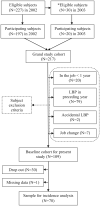Efficacy of the revised NIOSH lifting equation to predict risk of low-back pain associated with manual lifting: a one-year prospective study
- PMID: 24669544
- PMCID: PMC4634706
- DOI: 10.1177/0018720813513608
Efficacy of the revised NIOSH lifting equation to predict risk of low-back pain associated with manual lifting: a one-year prospective study
Abstract
Objective: The objective was to evaluate the efficacy of the Revised National Institute for Occupational Safety and Health (NIOSH) lifting equation (RNLE) to predict risk of low-back pain (LBP).
Background: In 1993, NIOSH published the RNLE as a risk assessment method for LBP associated with manual lifting. To date, there has been little research evaluating the RNLE as a predictor of the risk of LBP using a prospective design.
Methods: A total of 78 healthy industrial workers' baseline LBP risk exposures and self-reported LBP at one-year follow-up were investigated. The composite lifting index (CLI), the outcome measure of the RNLE for analyzing multiple lifting tasks, was used as the main risk predictor. The risk was estimated using the mean and maximum CLI variables at baseline and self-reported LBP during the follow-up. Odds ratios (ORs) were calculated using a logistic regression analysis adjusted for covariates that included personal factors, physical activities outside of work, job factors, and work-related psychosocial characteristics.
Results: The one-year self-reported LBP incidence was 32.1%. After controlling for history of prior LBP, supervisory support, and job strain, the categorical mean and maximum CLI above 2 had a significant relationship (OR = 5.1-6.5) with self-reported LBP, as compared with the CLI below or equal to I. The correlation between the continuous CLI variables and LBP was unclear.
Conclusions: The CLI > 2 threshold may be useful for predicting self-reported LBP. Research with a larger sample size is needed to clarify the exposure-response relationship between the CLI and LBP.
Figures
Similar articles
-
The NIOSH lifting equation and low-back pain, Part 1: Association with low-back pain in the backworks prospective cohort study.Hum Factors. 2014 Feb;56(1):6-28. doi: 10.1177/0018720813486669. Hum Factors. 2014. PMID: 24669540
-
The NIOSH lifting equation and low-back pain, Part 2: Association with seeking care in the backworks prospective cohort study.Hum Factors. 2014 Feb;56(1):44-57. doi: 10.1177/0018720813491284. Hum Factors. 2014. PMID: 24669542
-
Evaluation of the Impact of the Revised National Institute for Occupational Safety and Health Lifting Equation.Hum Factors. 2016 Aug;58(5):667-82. doi: 10.1177/0018720815623894. Epub 2016 Jan 28. Hum Factors. 2016. PMID: 26822795 Free PMC article.
-
Efficacy of the revised NIOSH lifting equation to predict risk of low back pain due to manual lifting: expanded cross-sectional analysis.J Occup Environ Med. 2011 Sep;53(9):1061-7. doi: 10.1097/JOM.0b013e31822cfe5e. J Occup Environ Med. 2011. PMID: 21866048
-
Understanding outcome metrics of the revised NIOSH lifting equation.Appl Ergon. 2019 Nov;81:102897. doi: 10.1016/j.apergo.2019.102897. Epub 2019 Jul 23. Appl Ergon. 2019. PMID: 31422239
Cited by
-
Wearable Sensors and Artificial Intelligence for Physical Ergonomics: A Systematic Review of Literature.Diagnostics (Basel). 2022 Dec 5;12(12):3048. doi: 10.3390/diagnostics12123048. Diagnostics (Basel). 2022. PMID: 36553054 Free PMC article. Review.
-
Workplace Psychosocial Factors, Work Organization, and Physical Exertion as Risk Factors for Low Back Pain Among US Workers: Data From the 2015 National Health Interview Survey.J Occup Environ Med. 2024 Jun 1;66(6):467-474. doi: 10.1097/JOM.0000000000003087. Epub 2024 Mar 13. J Occup Environ Med. 2024. PMID: 38471812 Free PMC article.
-
sEMG Spectral Analysis and Machine Learning Algorithms Are Able to Discriminate Biomechanical Risk Classes Associated with Manual Material Liftings.Bioengineering (Basel). 2023 Sep 20;10(9):1103. doi: 10.3390/bioengineering10091103. Bioengineering (Basel). 2023. PMID: 37760205 Free PMC article.
-
Tactile Gloves Predict Load Weight During Lifting With Deep Neural Networks.IEEE Sens J. 2023 Jun;23(16):18798-18809. doi: 10.1109/jsen.2023.3289670. IEEE Sens J. 2023. PMID: 40160413 Free PMC article.
-
Workplace Psychosocial Factors and Their Association With Musculoskeletal Disorders: A Systematic Review of Longitudinal Studies.Workplace Health Saf. 2023 Dec;71(12):578-588. doi: 10.1177/21650799231193578. Epub 2023 Sep 12. Workplace Health Saf. 2023. PMID: 37698343 Free PMC article.
References
-
- Bernard B. A critical review of epidemiologic evidence for work-related musculoskeletal disorders of the neck, upper extremity, and low back. Washington, DC: U.S. Department of Health and Human Services, Center for Disease Control and Prevention, National Institute for Occupational Safety and Health; 1997.
-
- Bigos SJ, Spengler DM, Martin NA, Zeh J, Fisher L, Nachemson A, Wang MH. Back injuries in industry: A retrospective study. II. Injury factors. Spine. 1986;11:246–251. - PubMed
-
- Boda S, Bhoyar P, Garg A. Validation of revised NIOSH Lifting Equation and 3D SSP model to predict risk of work-related low back pain. Paper presented at the 54th Human Factors and Ergonomics Society annual meeting; San Francisco, CA. 2010. Sep,
-
- Burdorf A. Exposure assessment of risk factors for disorders of the back in occupational epidemiology. Scandinavian Journal of Work, Environment & Health. 1992;18:1–9. - PubMed
MeSH terms
Grants and funding
LinkOut - more resources
Full Text Sources
Other Literature Sources
Medical
Research Materials
Miscellaneous


